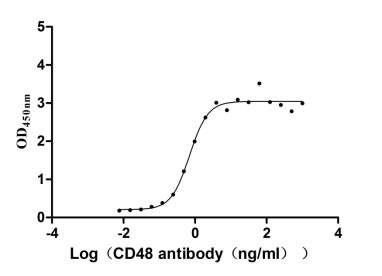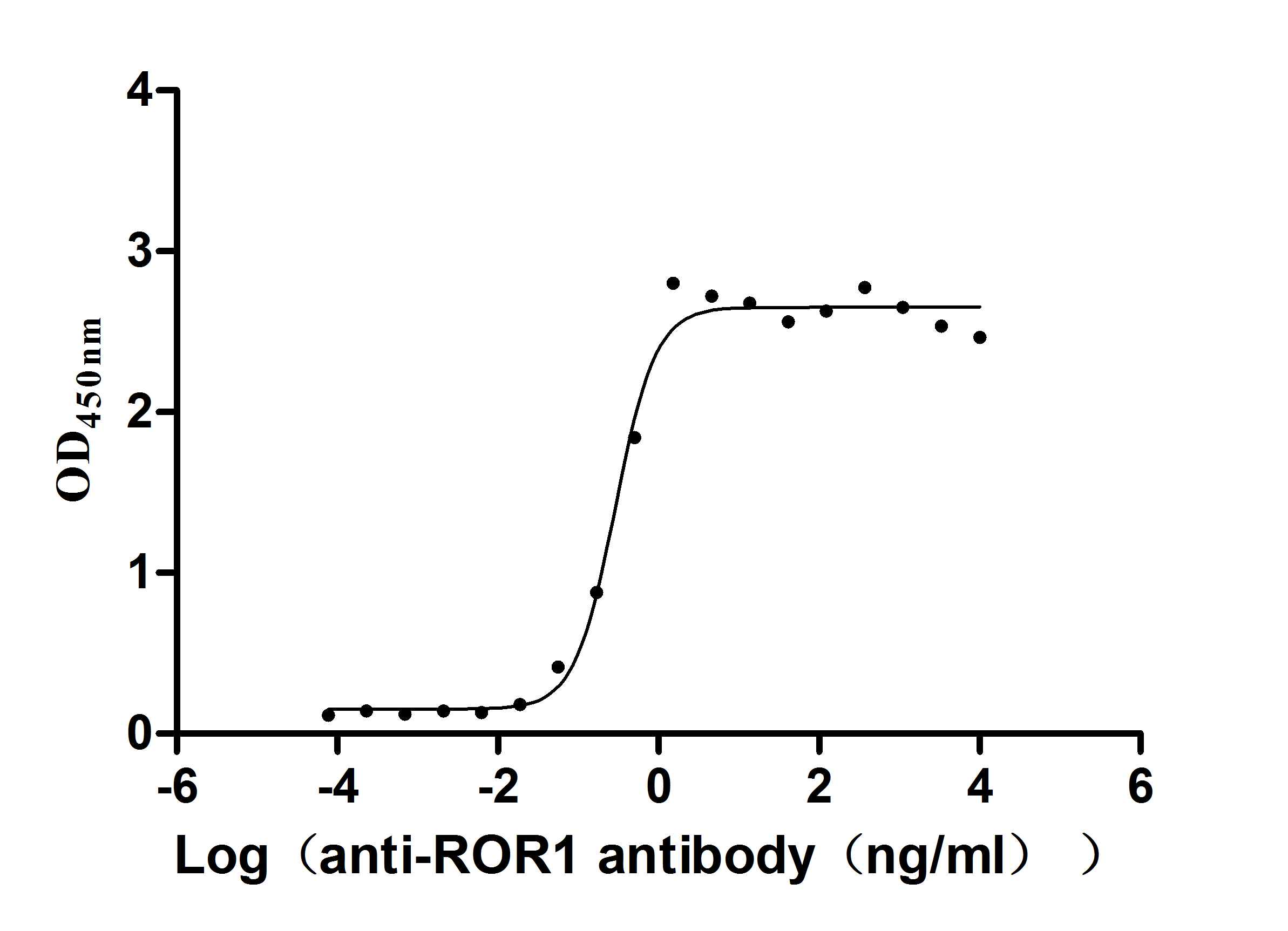Recombinant Mouse DNA dC->dU-editing enzyme APOBEC-3 (Apobec3)
-
中文名称:Recombinant Mouse DNA dC->dU-editing enzyme APOBEC-3(Apobec3),Yeast
-
货号:CSB-YP859956MO
-
规格:
-
来源:Yeast
-
其他:
-
中文名称:Recombinant Mouse DNA dC->dU-editing enzyme APOBEC-3(Apobec3),Yeast
-
货号:CSB-EP859956MO
-
规格:
-
来源:E.coli
-
其他:
-
中文名称:Recombinant Mouse DNA dC->dU-editing enzyme APOBEC-3(Apobec3),Yeast
-
货号:CSB-EP859956MO-B
-
规格:
-
来源:E.coli
-
共轭:Avi-tag Biotinylated
E. coli biotin ligase (BirA) is highly specific in covalently attaching biotin to the 15 amino acid AviTag peptide. This recombinant protein was biotinylated in vivo by AviTag-BirA technology, which method is BriA catalyzes amide linkage between the biotin and the specific lysine of the AviTag.
-
其他:
-
中文名称:Recombinant Mouse DNA dC->dU-editing enzyme APOBEC-3(Apobec3),Yeast
-
货号:CSB-BP859956MO
-
规格:
-
来源:Baculovirus
-
其他:
-
中文名称:Recombinant Mouse DNA dC->dU-editing enzyme APOBEC-3(Apobec3),Yeast
-
货号:CSB-MP859956MO
-
规格:
-
来源:Mammalian cell
-
其他:
产品详情
-
纯度:>85% (SDS-PAGE)
-
基因名:Apobec3
-
Uniprot No.:
-
别名:Apobec3DNA dC->dU-editing enzyme APOBEC-3; EC 3.5.4.38; Apolipoprotein B mRNA-editing complex 3; Arp3; CEM-15; CEM15
-
种属:Mus musculus (Mouse)
-
蛋白长度:full length protein
-
表达区域:1-429
-
氨基酸序列MGPFCLGCSH RKCYSPIRNL ISQETFKFHF KNLGYAKGRK DTFLCYEVTR KDCDSPVSLH HGVFKNKDNI HAEICFLYWF HDKVLKVLSP REEFKITWYM SWSPCFECAE QIVRFLATHH NLSLDIFSSR LYNVQDPETQ QNLCRLVQEG AQVAAMDLYE FKKCWKKFVD NGGRRFRPWK RLLTNFRYQD SKLQEILRPC YIPVPSSSSS TLSNICLTKG LPETRFCVEG RRMDPLSEEE FYSQFYNQRV KHLCYYHRMK PYLCYQLEQF NGQAPLKGCL LSEKGKQHAE ILFLDKIRSM ELSQVTITCY LTWSPCPNCA WQLAAFKRDR PDLILHIYTS RLYFHWKRPF QKGLCSLWQS GILVDVMDLP QFTDCWTNFV NPKRPFWPWK GLEIISRRTQ RRLRRIKESW GLQDLVNDFG NLQLGPPMS
-
蛋白标签:Tag type will be determined during the manufacturing process.
The tag type will be determined during production process. If you have specified tag type, please tell us and we will develop the specified tag preferentially. -
产品提供形式:Lyophilized powder
Note: We will preferentially ship the format that we have in stock, however, if you have any special requirement for the format, please remark your requirement when placing the order, we will prepare according to your demand. -
复溶:We recommend that this vial be briefly centrifuged prior to opening to bring the contents to the bottom. Please reconstitute protein in deionized sterile water to a concentration of 0.1-1.0 mg/mL.We recommend to add 5-50% of glycerol (final concentration) and aliquot for long-term storage at -20℃/-80℃. Our default final concentration of glycerol is 50%. Customers could use it as reference.
-
储存条件:Store at -20°C/-80°C upon receipt, aliquoting is necessary for mutiple use. Avoid repeated freeze-thaw cycles.
-
保质期:The shelf life is related to many factors, storage state, buffer ingredients, storage temperature and the stability of the protein itself.
Generally, the shelf life of liquid form is 6 months at -20°C/-80°C. The shelf life of lyophilized form is 12 months at -20°C/-80°C. -
货期:Delivery time may differ from different purchasing way or location, please kindly consult your local distributors for specific delivery time.Note: All of our proteins are default shipped with normal blue ice packs, if you request to ship with dry ice, please communicate with us in advance and extra fees will be charged.
-
注意事项:Repeated freezing and thawing is not recommended. Store working aliquots at 4°C for up to one week.
-
Datasheet :Please contact us to get it.
靶点详情
-
功能:DNA deaminase (cytidine deaminase) which acts as an inhibitor of retrovirus replication and retrotransposon mobility via deaminase-dependent and -independent mechanisms. Selectively targets single-stranded DNA and does not deaminate double-stranded DNA or single- or double-stranded RNA. Exhibits antiviral activity against HIV-1, simian immunodeficiency viruses (SIVs), mouse mammary tumor virus (MMTV) and friend murine leukemia virus (FrMLV) and may inhibit the mobility of LTR retrotransposons.
-
基因功能参考文献:
- The distribution of AID and A3s in the epithelial cells as well as germinal centres. PMID: 29343743
- By developing transgenic mice with mutations in the cytidine deamination domains needed for enzymatic activity and interaction with viral RNA, the s show that APOBEC3 proteins can still restrict in vivo infection by interacting with reverse transcriptase and blocking its activity. PMID: 29593034
- our current work indicated that APOBEC3 copy number variations might have a good screening accuracy for breast cancer. PMID: 27602762
- APOBEC3 can restrict retroviruses in a type I interferon-independent manner in vivo. By contrast, the ability of APOBEC3 to promote neutralizing antibody responses is type I interferon-dependent. PMID: 28415995
- These results indicate that the mechanisms of APOBEC3 restriction of Koala Retrovirus by humanA3G and mouseA3 differ (deamination dependent vs. independent) and glyco-gag does not play a role in the restriction. PMID: 26253512
- The Apobec3/Rfv3-dependent neutralizing antibody response correlated with Friend virus-specific IgG2 titers and that the in vivo neutralization potency of Apobec3/Rfv3-resistant antisera was dependent on activating Fcgamma receptors. PMID: 25589647
- A3 shifts the balance, from the fast antibody response mediated by marginal zone B cells with little affinity maturation, to a more sustained germinal center B-cell response PMID: 25501566
- s find that the number of N-glycosylated residues in glycosylated Pr80 inversely correlates with the sensitivity of a gammaretrovirus to deamination by mouse APOBEC3. PMID: 25505062
- APOBEC3A and APOBEC3B are more abundant on protein level in chronic lymphocytic leukemia (CLL) than in AID, and clustered genomic C>T mutations outside the Ig locus occur at APOBEC3 hot spot motifs in IgV-Mut CLL. PMID: 24840555
- APOBEC3 acts as a key player in generating virus-specific neutralizing antibodies that could be harnessed for vaccine development. PMID: 24821801
- loss genotypes of APOBEC3 deletion predispose their carriers to epithelial ovarian cancer (EOC). PMID: 24577894
- The mA3 (APOBEC3) exon 5 is indeed a functional element that influences protein synthesis at a post-transcriptional level. PMID: 22275865
- Despite the fact that APOBEC3 in murine leukemia viruse particles does not induce detectable deaminations upon infection, its deaminase activity is easily detected in virus lysates. PMID: 24453360
- APOBEC3G inhibits DND1 function to regulate microRNA activity. PMID: 23890083
- HIV replication persists despite the inability of HIV to develop resistance to APOBEC3 in the absence of Vif. PMID: 23555255
- APOBEC3 restricted mouse mammary tumor virus through inhibition of early reverse transcription. PMID: 23449789
- IFN-alpha can act primarily through Apobec3 to inhibit acute infection of pathogenic Friend retrovirus in vivo. PMID: 23315078
- IFN-alpha and LPS induce Apobec3 via different pathways that can be manipulated to enhance the intracellular store of A3 and potentially enhance A3 antiviral function in the host. PMID: 22972924
- Loss of APOBEC3 gene facilitates efficient sexual transmission of murine leukemia virus. PMID: 22691411
- restriction of murine leukemia viruses by mouse APOBEC3 PMID: 22666481
- Apobec3 promotes the release of substantial levels of noninfectious virions in the plasma during acute Friend virus infection. PMID: 21998583
- novel mechanism in which APOBEC3G promotes colorectal cancer hepatic metastasis through inhibition of miR-29-mediated suppression of MMP2 PMID: 21985787
- Phosphorylation directly regulates the intrinsic DNA cytidine deaminase activity of activation-induced deaminase and APOBEC3G protein PMID: 21659520
- These data point to a role for APOBEC3 proteins in limiting infectivity of milk-transmitted viruses. PMID: 21147467
- This review discusses recent advances the understanding of the dynamic interplay of Vif with the antiviral APOBEC3 enzymes. PMID: 20538015
- The preponderance of evidence strongly indicates that Rfv3 is encoded by Apobec3, and while BAFF-R defects may exacerbate viremia in A/WySn mice, it is not Rfv3. PMID: 20980520
- report a murine leukemia virus (MuLV) that utilizes its glycosylated Gag protein (gGag) to evade APOBEC3 PMID: 20702647
- Data suggest that Apobec3 indirectly influences FV-specific neutralizing Ab responses by reducing virus-induced immune dysfunction. PMID: 20566830
- analysis of how small molecular compounds inhibit HIV-1 replication through specifically stabilizing APOBEC3G PMID: 20363737
- establishment of XMRV infection in patients may be dependent on infection of A3G/A3F-deficient cells, and cells expressing low levels of A3G/A3F, such as prostate cancer cells, may be ideal producers of infectious XMRV PMID: 20335265
- APOBEC3G markedly inhibits retrotransposition of IAP and MusD elements, and induces G-to-A hypermutations in their DNA copies PMID: 15674295
- both APOBEC2 (despite being an ancestral member of the family with no obvious redundancy in muscle) and APOBEC3 (despite its proposed role in restricting endogenous retrotransposition) are inessential for mouse development, survival, or fertility PMID: 16055735
- separation of function of the cytidine deaminase domains is maintained in hA3B and hA3F, but roles of the two domains are reversed in mouse A3 PMID: 17020885
- data indicate that APOBEC3G is not a restriction factor for vaccinia virus replication nor is vaccinia virus able to degrade APOBEC3G PMID: 17052331
- mouse A3-containing and human A3G-containing virions showed a marked decrease in titre; A3(-/-) mice were more susceptible to MMTV infection, because virus spread was more rapid and extensive than in their wild-type littermates PMID: 17259974
- These results for the first time suggest mA3 editing immediately preceding the integration event that led to retroviral endogenization, contributing to inactivation of infectivity. PMID: 17967065
- Study compared the antiviral activities of human and murine Apobec3 (A3), and found that, HIV is able to resist human A3G but is sensitive to murine A3, whereas murine leukemia virus is relatively resistant to murine A3 but sensitive to human A3G. PMID: 18032489
- APOBEC3 is not an essential mediator of the IFN-mediated inhibition of hepatitis B virus in vivo. PMID: 18434399
- The interaction of DND1 and APOBEC3 could be one mechanism for maintaining viability of germ cells and for preventing germ cell tumor development PMID: 18509452
- The inefficient incorporation of endogenous APOBEC3 (mA3) appears to be a strategy by which MLV escapes the inhibitory effect of mA3. PMID: 18572219
- IAPE and HERV-K elements are restricted at the entry, amplification and integration into their target genomes by the host APOBEC3 proteins. PMID: 18702815
- study demonstrates that Rfv3 is encoded by Apobec3; Apobec3 maps to the same chromosome region as Rfv3 and has broad inhibitory activity against retroviruses, including HIV PMID: 18772436
- upon infection with the pathogenic Friend virus complex, (BALB/c x C57BL/6)F(1) mice displayed an exacerbated erythroid cell proliferation when the mice carried a targeted disruption of the C57BL/6-derived APOBEC3 allele. PMID: 18786991
- APOBEC3G restricts replication and pathogenesis of M-MuLV in vivo PMID: 19150103
- Increasing the levels of this intrinsic antiretroviral factor in vivo can lead to increased levels of restriction because of higher levels of both cell-intrinsic as well as virion-packaged APOBEC3. PMID: 19153238
显示更多
收起更多
-
亚细胞定位:Cytoplasm.
-
蛋白家族:Cytidine and deoxycytidylate deaminase family
-
组织特异性:Expressed in spleen, node and lung.
-
数据库链接:
STRING: 10090.ENSMUSP00000105249
UniGene: Mm.284059
Most popular with customers
-
Recombinant Human CD48 antigen (CD48) (Active)
Express system: Mammalian cell
Species: Homo sapiens (Human)
-
Express system: Mammalian cell
Species: Homo sapiens (Human)
-
Recombinant Human Intestinal-type alkaline phosphatase (ALPI) (Active)
Express system: Mammalian cell
Species: Homo sapiens (Human)
-
Recombinant Human Claudin-6 (CLDN6)-VLPs (Active)
Express system: Mammalian cell
Species: Homo sapiens (Human)
-
Recombinant Rat Gastric inhibitory polypeptide receptor (Gipr), partial (Active)
Express system: Mammalian cell
Species: Rattus norvegicus (Rat)
-
Recombinant Human Interleukin-2 (IL2) (Active)
Express system: Mammalian cell
Species: Homo sapiens (Human)
-
Recombinant Human Myosin regulatory light chain 12B(MYL12B) (Active)
Express system: E.coli
Species: Homo sapiens (Human)
-
Recombinant Macaca fascicularis Zinc transporter ZIP6 isoform X1(SLC39A6),partial (Active)
Express system: Baculovirus
Species: Macaca fascicularis (Crab-eating macaque) (Cynomolgus monkey)





-AC1.jpg)














